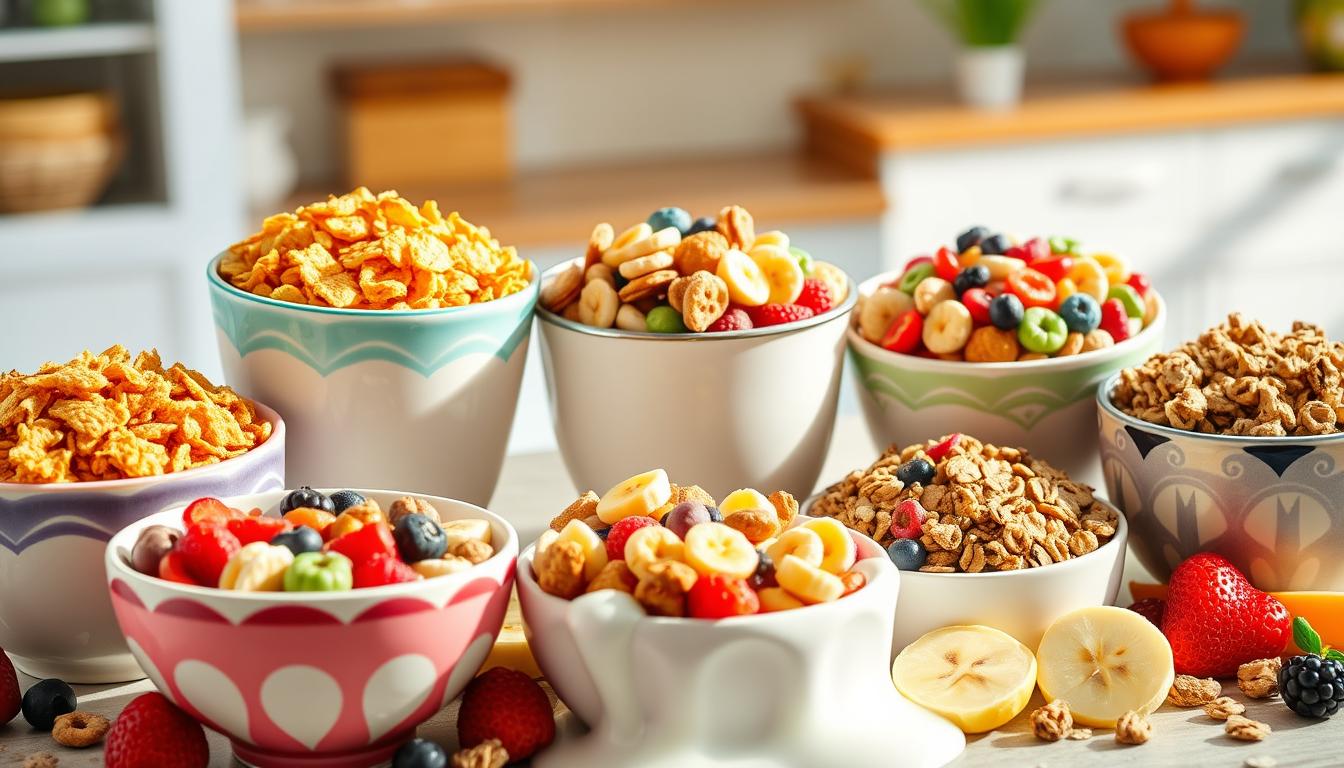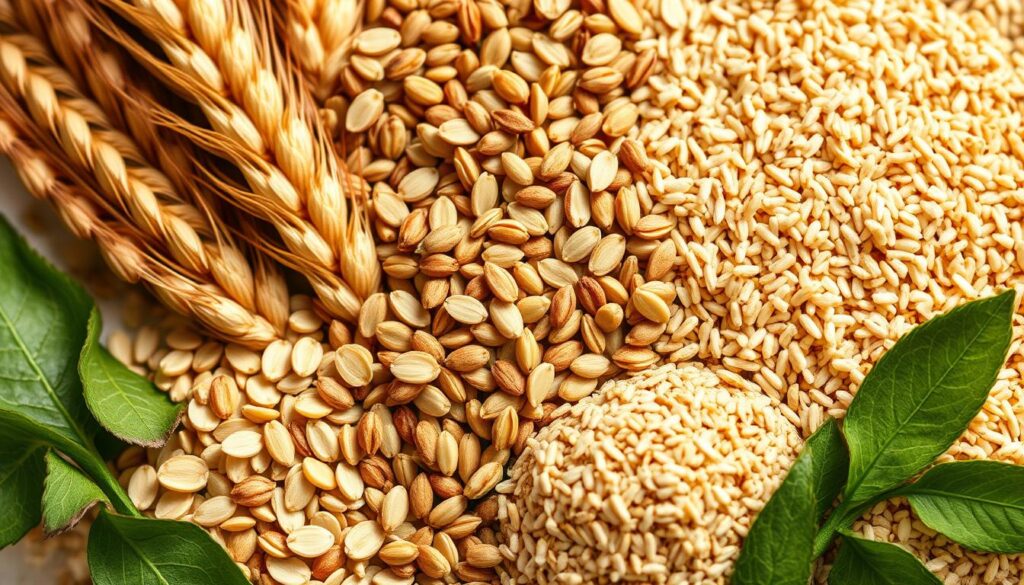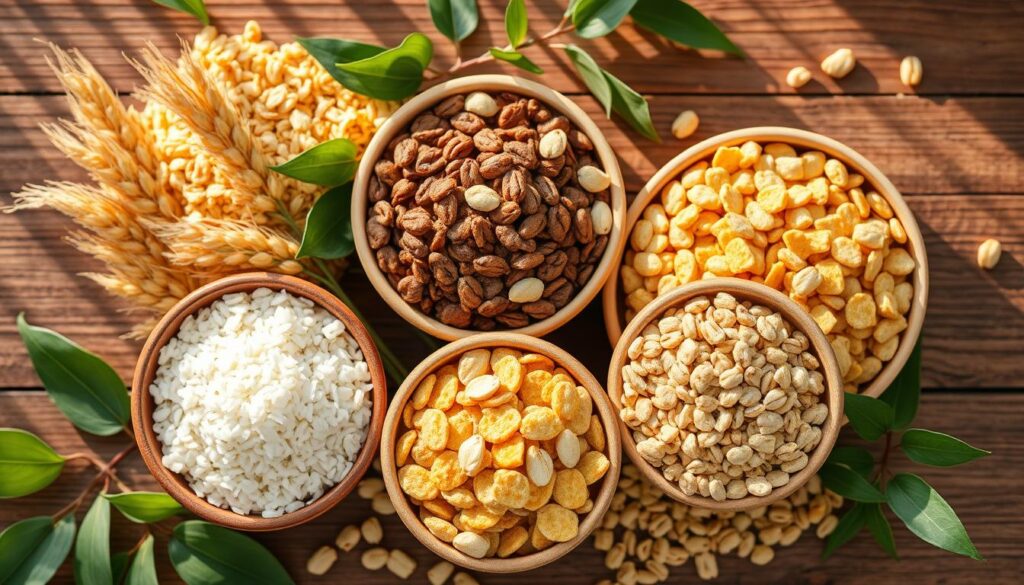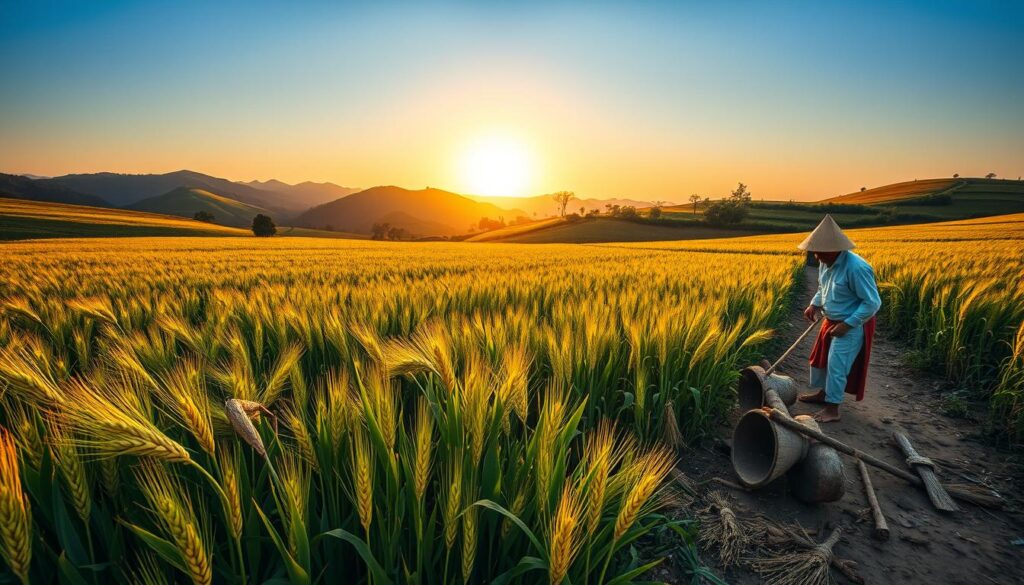Every morning, as sunlight fills my kitchen, I think about What are the 5 cereals?. These simple grains in our pantry hold thousands of years of history. They show the journey of human nutrition and farming.
Popular cereals are more than a quick start to the day. They connect us to our culture and offer vital nutrition. From the wheat fields of the Middle East to Asia’s rice paddies, these grains have fed people for centuries.
Learning about breakfast cereals is not just about taste. It’s about their nutritional value. These small seeds are a sign of human creativity and our skill in making meals from simple crops.
Key Takeaways
- Cereals are essential staple foods with deep historical roots
- Five key cereals shape global nutrition and cuisine
- Grains offer diverse nutritional benefits beyond basic sustenance
- Breakfast cereals represent cultural and agricultural innovation
- Nutritional diversity in grains supports overall human health
Understanding Cereal Grains and Their Nutritional Impact
5 cereals grains are key to our nutrition, giving us vital nutrients for health. They are a big part of our breakfasts and our global food systems.
Grains give us 48% of our daily calories, making them essential. They offer more than just food, with many health benefits.
The Role of Cereals in Modern Diet
Grain-based foods are divided into four main types:
- Whole grains (containing bran, endosperm, and germ)
- Refined grains (processed to remove bran and germ)
- Enriched grains (nutrients added back after processing)
- Fortified grains (additional nutrients incorporated)
Key Nutritional Benefits of Whole Grains
Whole grains are still popular, despite gluten-free options. They give us important nutrients like:
| Nutrient | Key Benefits |
|---|---|
| Fiber | Improves digestion and supports heart health |
| Vitamins | Supports metabolic functions and immune system |
| Minerals | Promotes bone strength and cellular processes |
Health Benefits of Regular Cereal Consumption
Eating different cereals regularly can help:
- Better weight management
- Reduced risk of chronic diseases
- Improved blood sugar regulation
- Enhanced digestive health
“Grains are not just food; they’re a nutritional powerhouse that has sustained human civilization for thousands of years.” – Nutritional Research Institute
Adding various healthy cereals to your diet can boost your nutrition. It supports your overall health and wellness.
What are the 5 cereals?
Exploring the world of cereals shows us 5 cereals grains. These are wheat, rice, corn, oats, and barley. Each has special traits that are vital for our diet and farming.
- Wheat: It’s the most grown cereal worldwide. It includes bread wheat and durum. Wheat is key in bread, pasta, and many foods.
- Rice: Billions rely on rice as a main food. It comes in many types and is vital in world cuisine.
- Corn: This crop is very flexible in food making. It’s known for its fiber, which helps with digestion.
- Oats: Oats are famous for their beta-glucan. This helps control blood sugar and lower cholesterol.
- Barley: Barley is loved for its beta-glucan too. It can lower cholesterol and cut down the risk of type 2 diabetes.
“Cereals are the foundation of human nutrition, connecting us to thousands of years of agricultural history.”
Knowing about these cereals helps us make better food choices. Each grain offers special health benefits. Together, they help us eat well and stay healthy.
| Cereal | Key Nutritional Benefit | Global Significance |
|---|---|---|
| Wheat | High in protein and fiber | Most widely cultivated cereal |
| Rice | Provides essential carbohydrates | Primary food source for Asia |
| Corn | Rich in fiber and antioxidants | Used in multiple food products |
| Oats | Lowers cholesterol | Popular in health-conscious diets |
| Barley | Supports heart health | Used in brewing and food |
Ancient Origins and Evolution of Cereal Grains
Cereal varieties have a rich history that goes back thousands of years. They have been a key part of human life, from ancient times to today. Grains have always been important for our nutrition and growth.
The history of cereal grains is amazing. Archaeologists found ancient grain silos in Jordan that are 11,000 years old. They had barley and early wheat varieties inside. Ancient people valued grains so much, they even used them as money.
Historical Significance in Human Civilization
Grains were vital in changing human societies. Here are some important facts:
- Workers building the Great Pyramids were paid with bread and beer
- About 50% of all grains grown are eaten by people
- Grains give us about 48% of our daily calories
Development of Modern Cereal Varieties
The growth of 5 cereals is incredible. In 1970, there were 160 breakfast cereals. By 2012, there were about 5,000 types. This growth shows how farming and tastes have changed.
“Grains are the foundation of human nutrition, connecting our past to our present through sustainable agriculture and diverse culinary traditions.”
Today’s cereals come from thousands of years of farming. They mix old wisdom with new science. Your choices today show a long journey of human creativity and change.
Wheat: The World’s Most Popular Cereal Grain
Wheat is a key player in the world of 5 cereals grains, leading in both agriculture and nutrition. It’s one of the top five cereals, crucial for feeding people everywhere. You probably eat wheat every day, in foods like bread and pasta, showing its wide use.
- Robust protein content
- Complex carbohydrates
- Vital B vitamins
- Important minerals like magnesium and zinc
Wheat comes in different types, each with its own strengths. Hard wheat is great for making bread, while soft wheat is better for pastries and cakes. This variety highlights wheat’s importance in food worldwide.
“Wheat has been humanity’s most transformative agricultural crop” – Agricultural Historians
But, gluten sensitivity has become a big issue for wheat. More people are looking for gluten-free options, pushing for new ways to process wheat and explore other grains.
| Wheat Type | Primary Use | Nutritional Highlight |
|---|---|---|
| Hard Red Winter | Bread Flour | High Protein |
| Soft White | Pastry Flour | Lower Protein |
| Durum | Pasta Production | Dense Texture |
Knowing how important wheat is helps us see its role in the five main cereals that feed the world. Its ability to adapt and its nutritional value make it a vital part of our diet.
Rice: A Global Staple with Diverse Varieties
Rice is a key food for over 50% of the world’s people. It’s one of the five main cereals, known for its variety and nutrition. This makes it a vital part of many cuisines around the world.
The world of rice is vast and complex. It includes many types, each with its own traditions. Knowing about these varieties can help you choose better foods.
Types of Rice and Their Global Significance
- Indica rice: Accounts for 62-66% of global rice trade
- Aromatic rice (jasmine and basmati): Represents 23-25% of global trade
- Japonica rice: Contributes 9-10% of global rice trade
- Specialty rice types: Make up 2-3% of global production
Nutritional Profile of Rice Varieties
Each type of rice has its own nutritional perks. Brown rice is especially good, with about 8% protein and important minerals. It’s also gluten-free, great for those with certain diets.
Cooking Methods and Best Practices
Getting rice just right involves knowing about moisture and cooking methods. Chefs say to lower rice moisture to about 14% for best results.
“Rice is not just food; it’s a cultural heritage that connects billions of people worldwide.” – Anonymous Chef
Whether you’re looking at different cereals or gluten-free options, rice is a flexible and healthy choice. It meets many dietary needs.
Corn: Versatility and Cultural Significance
Corn is a remarkable cereal grain with a long history and global impact. It’s one of the five essential cereals, evolving from an indigenous crop to a worldwide agricultural giant. Its journey started about 10,000 years ago in southern Mexico, where indigenous peoples first domesticated it.
Corn’s adaptability makes it a key player in cereal varieties. It grows from Canada to South America, maturing almost every month of the year. This grain serves many purposes across different sectors.
“Corn is not just a crop; it’s a cultural cornerstone that connects communities and economies worldwide.”
Corn Varieties and Uses
- Dent Corn: Primarily used for animal feed and food manufacturing
- Sweet Corn: Consumed fresh, frozen, or canned
- Popcorn: Popular snack and entertainment staple
- Flour Corn: Ground into cornmeal and used in baking
- Flint Corn: Decorative and used in traditional dishes
In the United States, over 90% of corn is genetically modified. These modifications improve crop yield and sustainability.
| Corn Type | Primary Use | Unique Characteristics |
|---|---|---|
| Dent Corn | Animal Feed | Contains a distinctive dent on the kernel top |
| Sweet Corn | Human Consumption | High sugar content, translucent seeds |
| Popcorn | Snack Production | Special hard kernel that expands when heated |
Whether you’re looking at breakfast cereals or agricultural innovations, corn is key. It has immense cultural and economic significance.
Oats: The Breakfast Champion
Oats are a nutritional powerhouse among the 5 cereals, offering great health benefits. They are loved by those who want nutritious and tasty meals.
Exploring Oat Varieties
Different types of oats offer unique textures and cooking experiences. They are perfect for those who love healthy cereals:
- Steel-cut oats: Minimally processed, with a hearty texture
- Rolled oats: Traditional option for quick preparation
- Instant oats: Convenient for rapid breakfast solutions
Nutritional Powerhouse
Oats are packed with nutritional benefits in every serving:
| Nutritional Aspect | Value per Serving |
|---|---|
| Fiber Content | 4 grams |
| Protein | 5 grams |
| Manganese | 68% daily value |
| Calories | 150 nutrient-dense calories |
Health Benefits and Applications
Studies show oats have amazing health benefits. A Tufts University study found that kids who eat oatmeal for breakfast do better in school. The soluble fiber in oats also helps control blood sugar and supports heart health.
“Oats are not just a breakfast food, they’re a nutritional investment in your well-being.”
You can use oats in many meals, not just breakfast. They are great in baking and smoothies, making them a versatile choice for healthy eating.
Barley: Ancient Grain with Modern Benefits
Barley is a top choice among cereals, known for its nutrition and history. It’s one of the five key grains, offering health perks that are perfect for today’s diets.
“Barley is not just a grain, but a nutritional treasure trove waiting to be explored.” – Nutrition Expert
Looking at the five main cereals, barley really shines. It’s packed with fiber, especially beta-glucan, which is great for your health.
- High in soluble fiber
- Supports heart health
- Helps regulate blood sugar
- Provides essential minerals
Healthy cereals like barley do more than just feed you. They have special qualities that boost your well-being.
| Nutritional Benefit | Impact |
|---|---|
| Beta-Glucan Fiber | Reduces cholesterol levels |
| Selenium | Supports immune function |
| Iron | Promotes healthy blood cells |
Barley is great in soups, as a side, or even in beer. Its long history and health benefits make it a nutritional superstar.
Conclusion
Learning about the 5 cereals is just the start of your health journey. Wheat, rice, corn, oats, and barley are full of health benefits. They can change your diet for the better.
Exploring different cereals is more than picking food. It’s about choosing wisely for your health. Studies show whole grains are good for you. They help with weight, reduce obesity risks, and improve health.
By picking cereals with 5 grams of fiber and less sugar, you improve your diet. The world of grains is growing, with new trends like ancient grains and gluten-free options. These five cereals are great for breakfast, meals, or snacks.
They offer tasty and healthy choices. By trying different cereals, you can feel better, have more energy, and live a fuller life.
As nutrition science grows, one thing is clear: whole grains are key to a healthy diet. By choosing these cereals, you’re not just eating. You’re investing in your health and happiness for the future.
FAQ
What are the five most essential cereal grains?
The top five cereal grains are wheat, rice, corn, oats, and barley. They are key to global nutrition. They give us essential nutrients, energy, and variety in our diets.
Are all cereals gluten-free?
No, not all cereals are gluten-free. Wheat, barley, and some oats have gluten. But, rice and corn are naturally gluten-free. They are great for those with gluten issues.
Which cereal is the most nutritious?
Each cereal has its own health benefits. Oats are great for heart health and fiber. Wheat is a good protein source. Rice gives quick energy, corn is full of antioxidants, and barley is good for digestion. Eating a variety of these grains is best.
How do whole grain cereals differ from refined cereals?
Whole grain cereals have the whole kernel – bran, germ, and endosperm. They are packed with fiber, vitamins, and minerals. Refined cereals, on the other hand, have been processed to lose these nutrients.
Can cereals help with weight management?
Yes, whole grain cereals can help with weight management. They are high in fiber, which keeps you full and helps with blood sugar and metabolism. Oats and barley are especially good for weight control.
Are cereals suitable for people with dietary restrictions?
Many cereals fit different dietary needs. Rice and corn are gluten-free, and oats can be too if processed right. All cereals offer options for vegetarians and vegans. Always check the labels for details.
How can I incorporate more cereals into my diet?
You can add cereals in many ways. Use oats in porridge, barley in soups, and rice as a side. Add corn to salads and enjoy wheat-based foods. Trying different grains can make your meals healthier and more fun.




